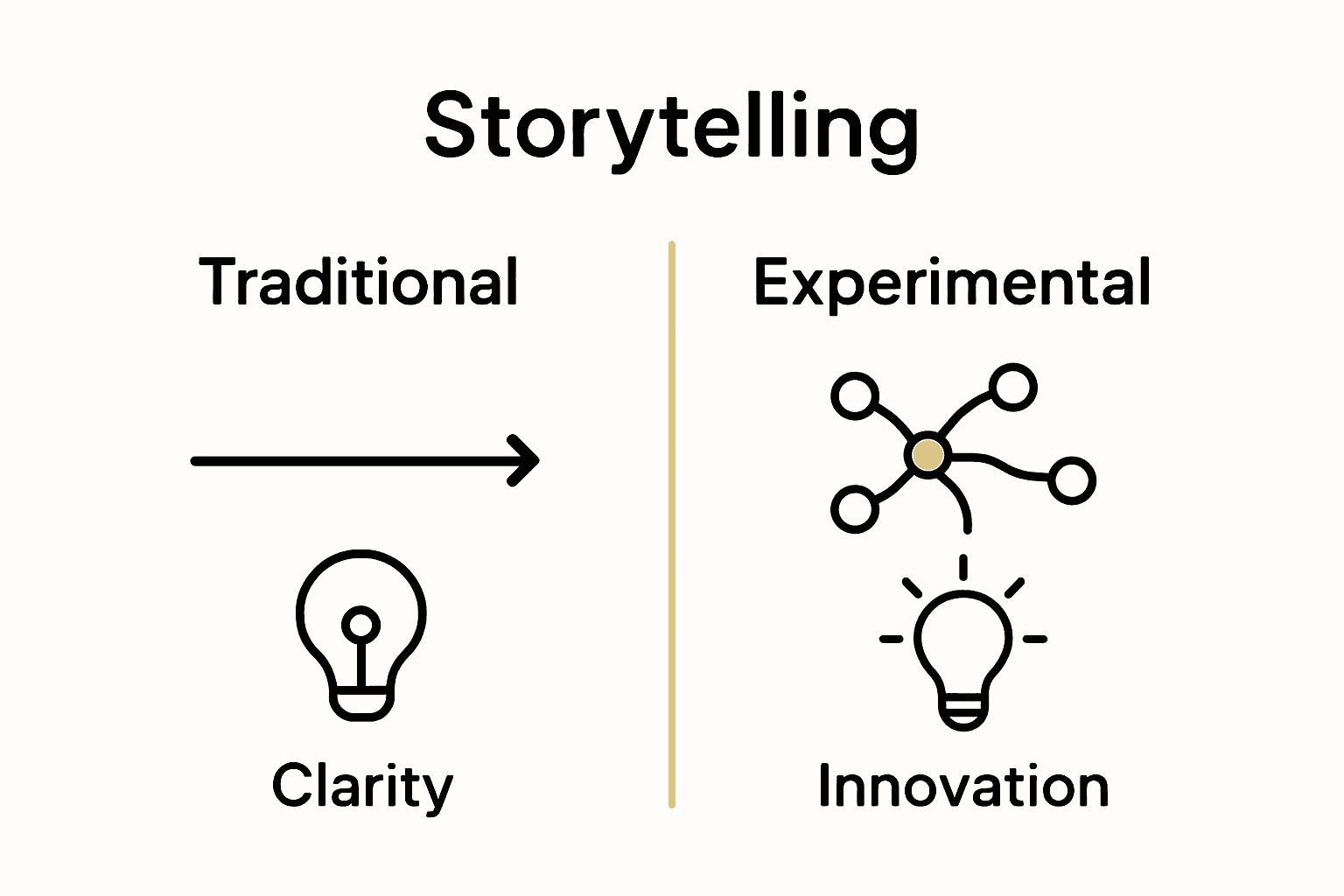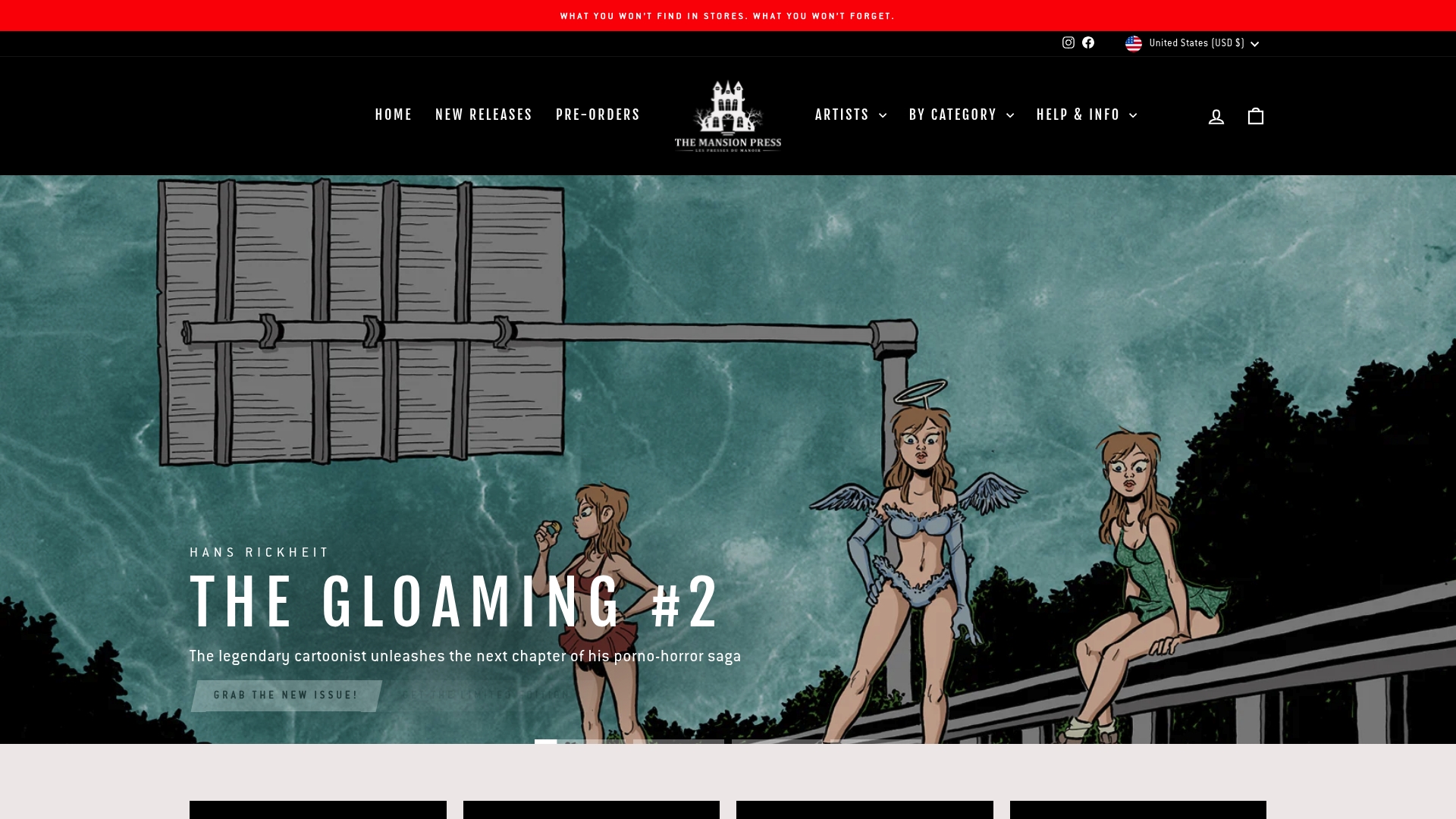Complete Guide to Experimental Storytelling Techniques
Did you know that one in five readers now seeks out stories that break traditional narrative rules? Experimental storytelling is changing how people experience literature, blending bold visuals, interactive elements, and unexpected twists in structure. These inventive approaches appeal to anyone curious about new ways to connect with stories, inviting readers and creators to rethink what a narrative can be and how it can make an impact.
Table of Contents
- Defining Experimental Storytelling Techniques
- Key Variations and Narrative Formats
- Visual and Structural Innovations in Storytelling
- Interactive and Immersive Approaches Explained
- Common Pitfalls and How to Avoid Them
Key Takeaways
| Point | Details |
|---|---|
| Experimental Storytelling Redefines Narratives | This approach breaks traditional storytelling rules, inviting radical exploration and innovative techniques. |
| Key Experimental Techniques | Techniques include nonlinear narratives, stream of consciousness, and metafiction, designed to engage and challenge audiences. |
| Visual and Structural Innovations | Incorporating multimodal elements like typography, images, and interactive designs transforms reader engagement and expands narrative possibilities. |
| Navigating Creative Pitfalls | Artists must balance innovation with clarity to avoid obscuring meaning and maintain audience connection in experimental narratives. |
Defining Experimental Storytelling Techniques
Experimental storytelling represents an artistic rebellion against traditional narrative structures, pushing creative boundaries to reimagine how stories can be told. According to ebsco, experimental literature involves writers deliberately breaking established literary rules to create innovative new approaches that challenge conventional storytelling norms.
At its core, experimental storytelling is about radical narrative exploration. Fiveable defines this approach as creating unique narrative techniques that fundamentally disrupt traditional forms and structures. These techniques aren’t merely variations on existing methods – they represent complete reimaginings of storytelling possibilities.
The key characteristics of experimental storytelling include:
- Deliberate disruption of linear narrative structures
- Challenging audience expectations
- Incorporating unconventional visual or textual elements
- Blending multiple artistic mediums
- Prioritizing artistic expression over traditional storytelling rules
For artists and creators interested in exploring this dynamic approach, experimental storytelling in comics offers an excellent starting point to understand how visual narratives can push creative boundaries. By embracing uncertainty and rejecting rigid storytelling conventions, experimental techniques open up entirely new realms of artistic communication.
Key Variations and Narrative Formats
Experimental storytelling encompasses a rich landscape of narrative variations that challenge traditional storytelling conventions. Studysmarter highlights that experimental prose includes unconventional narrative structures, blending different genres, and employing fragmented or stream-of-consciousness writing techniques that fundamentally reimagine narrative presentation.
One of the most prominent experimental narrative formats is the nonlinear narrative. According to en.wikipedia, this technique involves portraying events out of chronological order, utilizing methods like parallel plot lines or dream-state immersions. These approaches deliberately disrupt linear storytelling, forcing audiences to actively engage with the narrative’s construction and meaning.
Key variations in experimental narrative formats include:
Here’s a summary of key experimental narrative formats:
| Format | Main Technique | Audience Effect |
|---|---|---|
| Nonlinear Narrative | Events out of order | Active engagement required |
| Stream of Consciousness | Raw internal thought flow | Immersive, intimate experience |
| Fragmented Narratives | Non-sequential segments | Disorientation, reflection |
| Multilinear Storytelling | Multiple story threads | Choice and replayability |
| Metafiction | Acknowledges its own fictionality | Challenges expectations |
| Hybrid Genre | Mixes multiple genres | Unpredictable, broad appeal |
- Stream of Consciousness: Capturing raw, unfiltered mental experiences
- Fragmented Narratives: Breaking stories into non-sequential segments
- Multilinear Storytelling: Presenting multiple simultaneous narrative threads
- Metafictional Approaches: Stories that self-consciously acknowledge their fictional nature
- Hybrid Genre Narratives: Blending multiple storytelling styles and genres
For creators looking to explore these innovative narrative techniques, understanding narrative structure in graphic novels provides valuable insights into how visual storytelling can push artistic boundaries. By embracing these experimental formats, artists can create immersive experiences that challenge readers’ perceptions and expand the potential of storytelling itself.

Visual and Structural Innovations in Storytelling
Visual storytelling has dramatically expanded the boundaries of narrative expression, pushing beyond traditional text-based formats. en.wikipedia reveals the emergence of hybrid novels, which ingeniously incorporate diverse storytelling methods including photography, collage, maps, diagrams, posters, and illustrations to create immersive narrative experiences.
Experimental storytellers are increasingly challenging conventional communication methods. Studysmarter highlights how innovative prose now integrates unconventional typography and multimedia elements to enhance storytelling, transforming the reader’s engagement with narrative structures.
Key visual and structural innovations include:
- Multimodal Narratives: Combining text, images, and interactive elements
- Spatial Storytelling: Using physical layout and page design to convey meaning
- Typographic Experimentation: Manipulating text appearance to create emotional resonance
- Visual Metaphor Integration: Using graphic elements to represent abstract concepts
- Interactive Narrative Designs: Allowing readers to influence story progression
For artists seeking to explore these groundbreaking approaches, understanding visual narrative provides crucial insights into how visual elements can transform storytelling. By embracing these innovative techniques, creators can craft narratives that transcend traditional boundaries, offering audiences more dynamic and immersive storytelling experiences.
Interactive and Immersive Approaches Explained
Interactive storytelling represents a groundbreaking frontier in narrative design, transforming passive consumption into active engagement. Arxiv introduces the fascinating concept of physiologically driven storytelling, an innovative approach that dynamically adapts narratives based on the reader’s physiological state, creating uniquely personalized experiences that respond in real-time to audience emotional and physical reactions.
Beyond technological adaptations, interactive storytelling encompasses multiple approaches that invite audience participation. While en.wikipedia highlights storytelling methods traditionally used in educational contexts, contemporary artists are expanding these techniques into immersive narrative experiences that blur the lines between creator and audience.
Key interactive storytelling approaches include:
- Choose-Your-Own-Adventure Narratives: Allowing readers to determine story progression
- Responsive Digital Narratives: Stories that change based on user interactions
- Participatory Storytelling: Narratives co-created by audience members
- Augmented Reality Experiences: Blending physical and digital narrative spaces
- Physiological Response Narratives: Stories that adapt to reader’s emotional states
For artists eager to explore these cutting-edge techniques, experimental graphic storytelling provides critical insights into pushing narrative boundaries. By embracing interactive approaches, creators can craft experiences that transform storytelling from a unidirectional communication into a dynamic, collaborative art form.
Common Pitfalls and How to Avoid Them
Experimental storytelling demands a delicate balance between innovation and comprehensibility. Plexways emphasizes that unconventional narrative structures must ultimately serve the story’s core purpose, cautioning creators against pursuing experimental techniques that might compromise narrative clarity and reader engagement.
Studysmarter highlights a critical challenge in experimental prose: the potential for reader disengagement. Experimental approaches require more cognitive effort from audiences, making it essential for creators to carefully craft their narrative to maintain interest and emotional connection.
Key pitfalls to avoid in experimental storytelling include:
- Obscurity Over Meaning: Prioritizing complexity at the expense of narrative purpose
- Technical Experimentation Without Emotional Depth: Focusing solely on form rather than feeling
- Neglecting Audience Accessibility: Creating narratives too challenging to comprehend
- Inconsistent Narrative Logic: Introducing experimental elements without clear underlying structure
- Overwhelming Sensory Input: Bombarding readers with too many unconventional elements
For artists seeking to navigate these challenges, understanding storytelling through abstract visuals offers valuable insights into balancing innovation with comprehensibility. By maintaining a thoughtful approach, creators can push artistic boundaries while ensuring their experimental narratives remain compelling and meaningful.

Explore Cutting-Edge Art and Narrative Innovation Today
Experimental storytelling pushes creative limits by breaking traditional rules and embracing radical narrative forms like nonlinear plots, stream of consciousness, and interactive experiences. The challenge many artists and creators face is finding unique, high-quality resources and inspiration to bring these visionary techniques to life while engaging audiences in meaningful ways. If you are passionate about exploring unconventional storytelling that balances artistic innovation with emotional depth this is the perfect moment to dive deeper.

Discover exclusive artbooks, limited-edition comics, and original artworks that embody experimental storytelling at their finest on The Mansion Press. Connect with independent artists who challenge norms through visual and narrative innovation. Start your journey by exploring experimental graphic storytelling to see how creators transform narratives beyond traditional forms. Don’t miss your chance to own groundbreaking works that inspire and captivate—visit The Mansion Press now and bring home a piece of storytelling evolution.
Frequently Asked Questions
What is experimental storytelling?
Experimental storytelling is an artistic approach that breaks traditional narrative structures, using innovative techniques to explore new ways of telling stories. It emphasizes creative expression and challenges conventional storytelling norms.
What are some key techniques used in experimental storytelling?
Key techniques include nonlinear narratives, stream of consciousness writing, fragmented narratives, multilinear storytelling, metafiction, and hybrid genre narratives. These methods disrupt traditional storytelling forms and engage the audience in unique ways.
How can visual elements enhance experimental storytelling?
Visual storytelling innovations, such as multimodal narratives, spatial storytelling, typographic experimentation, and interactive designs, can greatly enhance how narratives are communicated and experienced, allowing for a more immersive engagement with the story.
What are common pitfalls to avoid in experimental storytelling?
Common pitfalls include obscuring meaning with excessive complexity, failing to engage the audience emotionally, neglecting accessibility, introducing inconsistent narrative logic, and overwhelming readers with too many unconventional elements.
Recommended
- Experimental Storytelling in Comics: Complete Guide – The Mansion Press
- Experimental Graphic Storytelling: Exploring New Art Forms – The Mansion Press
- What Is Visual Storytelling? Complete Guide for Artists – The Mansion Press
- Understanding Experimental Illustration Techniques for Art Lovers – The Mansion Press
- Créer un storytelling percutant pour engager votre audience


